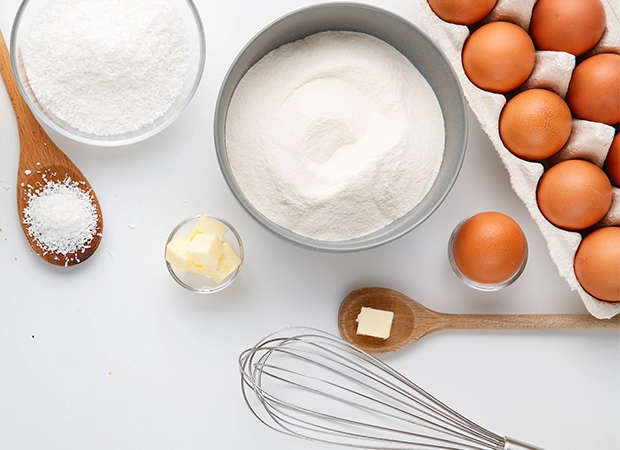Baking is a delightful pastime, but sometimes you don’t need a full batch of cookies or an entire cake. In such cases, it’s helpful to know how to halve baking recipes effectively. While it might seem as simple as dividing all the measurements by two, there are some nuances to consider to ensure your mini-batch of baked goods turns out just as delicious as the original. So here are our tips to ensure success.
1. Read the recipe
Before you begin, carefully read the entire recipe. This will give you a comprehensive understanding of the entire baking process that will need to be followed in order to get the desired results. Then, calculate what half of each ingredient is and make notes on the recipe itself.
Some recipes have critical steps that need to be followed precisely, such as specific mixing times or temperatures. It is important to note that baking temperatures will more often than not remain the same, even when halving recipes.
ALSO READ: 11 things that are guaranteed to turn you into a better baker
2. Use a kitchen scale
Precision is key in baking! Invest in a good kitchen scale to ensure accurate measurements, especially when dealing with smaller quantities. Weighing your ingredients provides more reliable results than using volume measurements.
3. Proportional reduction
For most ingredients, you can halve them directly. If a recipe calls for 2 cups of flour, use 1 cup, or if a recipe calls for ½ tsp of salt, use ¼ tsp of salt when halving. However, for ingredients such as eggs, it’s sometimes best to use one whole small egg instead of halving larger eggs.
But, if you do wish to halve eggs, it is important to pay special attention what size egg the recipe calls for. For example, if you wish to half a recipe that calls for an extra-large egg (large eggs usually weigh between 59g and 66g), start by placing a small, clean bowl on a scale that has been tared to zero, crack the egg into the bowl, jot down the weight of the whole egg, gently whisk the egg well to combine and then precisely weigh out only half of the whisked egg quantity.
4. Maintain ratios
Consider the ingredient ratios in the original recipe. If there’s a specific ratio of flour to sugar, for example, try to maintain that ratio when halving the recipe.
In most cases, the easiest way to maintain ratios when halving a recipe is to ensure that all ingredients have been halved equally or by the same amount. This attention to detail helps ensure the taste and texture remain consistent.
5. Adjust baking time
Halving a recipe can lead to shorter baking times. Start by taking off about 20 per cent of the total bake time and start checking for doneness from there. You’ll want to keep a close eye on your baked goods to avoid overcooking, and use a toothpick or cake tester to determine when they’re ready.
Pro tip: When baking cakes, brownies and cookies, when you can smell them from the oven, that’s usually a good indication that they’re ready to start testing for doneness!
6. Small-batch baking tools
Smaller baking pans and utensils are your friends when halving recipes, especially when it comes to cakes, puddings and brownies. So always make sure you have appropriately sized bakeware, which can make a significant difference in the outcome.
7. Use common sense
Trust your instinct! If a recipe calls for 3/4 cup of an ingredient, but your mixture looks too dry when halved to 3/8 cup, consider adding a bit more until the consistency looks right. Baking is both a science and an art, so some flexibility can be helpful when halving recipes.
8. Watch for leavening agents
Be cautious when reducing leavening agents such as baking powder and bicarbonate of soda. Cutting them in half directly can affect the rise of your baked goods. A general rule is to reduce them by half, but always consider the specific recipe and make adjustments as needed.
Baking powder vs bicarbonate of soda:
- While they are both common leavening agents used in baking, baking powder is a premix that already contains bicarbonate of soda.
- Bicarbonate of soda is a pure leavening agent and must be mixed with moisture and an acidic ingredient, such as lemon juice or buttermilk, to activate.
- Bicarbonate of soda is tangy so you need to be exact when measuring as it could leave the baked goods tasting bitter or soapy. Baking powder has no taste and can be used to help more neutrally flavoured goods rise nicely.
- Bicarbonate of soda has a unique colour that baking powder just can’t achieve. It will, therefore, result in baked goods having a nice golden hue.
- You can use bicarb instead of baking powder, but this may result in colour and texture differences. For example, if the recipe calls for 1 teaspoon of baking powder, substitute it with ½ teaspoon of bicarbonate of soda and then include an additional teaspoon of vinegar or lemon juice.
9. Keep notes
Take notes on the halved recipe, especially if it turns out exceptionally well or requires further adjustments. These notes will be invaluable for future reference and can save you time and effort.
10. Practise patience
Baking is a precise science, and sometimes it takes a bit of trial and error to get it just right. Don’t be discouraged if your first attempt isn’t perfect; learning from your experiences is all part of the fun!
ALSO READ: Baking hacks: 6 tips to avoid a dry, crumbly cake

